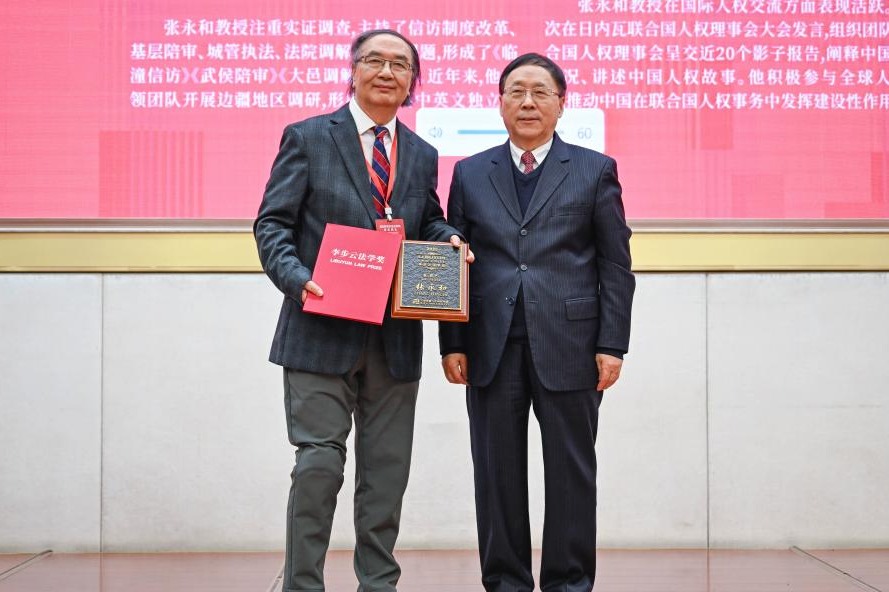Chinese satellites to enhance global early warning systems

China will launch three Fengyun geostationary meteorological satellites over the next two years to enhance global early warning systems, supporting the United Nations' Early Warnings for All initiative and helping billions fight climate change, a senior official said.
Chen Zhenlin, head of the China Meteorological Administration, said the satellites — one optical over the Indian Ocean, and one optical and one microwave over the western Pacific Ocean — are in their final phases of integration testing and are scheduled for launch between 2025 and 2026.
The deployment of these satellites will bring groundbreaking development to global early warning systems, Chen told China Daily in an exclusive interview ahead of World Meteorological Day, which falls on Sunday and is themed "Closing the Early Warning Gap Together".
"Their high-frequency monitoring capabilities will allow these satellites to take advantage of the window for disaster prevention," Chen said.
The Indian Ocean and the western Pacific regions are vulnerable to extreme weather events, including typhoons and torrential rainfall. Real-time monitoring by the Fengyun satellites will enable early detection of disaster precursors, buying crucial response time.
The microwave satellite, which is capable of penetrating cloud cover, will provide precise analysis of typhoon structures, improving the accuracy of their path and intensity forecasts. "This will give nations across Asia and the Pacific advance warnings ranging from hours to days," Chen said.
The optical satellites are capable of detecting heat waves and smoke from wildfires, while the microwave satellite can monitor changes in atmospheric moisture, helping in flood prediction. Together, they can track drought trends in Africa and conduct 3D observations of severe rainstorms in Southeast Asia, supporting climate resilience in countries involved in the Belt and Road Initiative.
Each of the optical satellites features a rapid scanning mode, providing minute-specific data for high-risk areas. "For instance, Pacific island nations will be able to predict the landfall of a severe cyclone 72 hours in advance," Chen said.
In line with global efforts to strengthen climate adaptation, China unveiled its Action Plan on Early Warning for Climate Change Adaptation (2025-27) during the COP29 UN climate conference in Baku, Azerbaijan, in November.
The action plan focuses on sharing China's expertise and technological prowess with developing economies to enhance disaster preparedness, minimize economic losses and reduce casualties from extreme weather events.
Under the plan, China will provide and co-develop cloud-based early warning systems, alongside capacity-building programs, Chen said, adding that a key feature is integrating satellite data, global numerical forecasting and AI-powered meteorological models to improve prediction accuracy and accessibility.
Multi-hazard monitoring will extend across meteorology, hydrology and marine fields, providing digital tools and interactive platforms to developing economies to close the technological gap.
"A cloud-based early warning system has already been deployed in Pakistan, the Solomon Islands and several other countries involved in the BRI, significantly enhancing their ability to respond to climate threats," Chen said.
The action plan also prioritizes the development of local expertise.
China will train 2,000 specialists, offer 100 scholarships and provide 50 visiting scholar positions over the next two years to help partner nations build independent meteorological and disaster response teams.
The plan was well received when it was unveiled last year, Chen noted.
Selwin Hart, special adviser to the UN secretary-general on climate action, called it the first national action plan directly supporting the UN's Early Warnings for All initiative, which was launched by UN Secretary-General Antonio Guterres in March 2022. The initiative called for every person on Earth to be protected by early warning systems by 2027.
Celeste Saulo, secretary-general of the World Meteorological Organization, highlighted the critical role of China's upcoming satellite launch in advancing global early warning capabilities.
Chen, from the China Meteorological Administration, said the country plans to expand cloud-based early warning platforms, with a focus on supporting African nations in building meteorological early warning systems. AI models and numerical forecasting technology will improve the accuracy of global meteorological disaster predictions, he said.
China will establish data service hubs in high-risk regions such as Africa, ASEAN countries and South Asia, aiming to bolster African drought and flood responses through cross-border meteorological disaster coordination.
"China is exploring trilateral cooperation with developed economies, including the United States and European nations, to expand the reach of early warning services," Chen said.
The country will continue implementing capacity-building programs for developing economies, including setting up joint laboratories and fostering international research collaborations to equip vulnerable countries with technical expertise, he added.
Beyond meteorology, China seeks to integrate early warning systems with UN sustainable development goals, using climate data to enhance food security in Africa and improve urban infrastructure resilience worldwide.
"The combination of Chinese technology and international cooperation will directly benefit billions of people, making a tangible contribution to global climate resilience," Chen said.
- China steps up cultural heritage protection to keep its past alive for the future
- Xi Focus: Navigating headwinds and charting new blueprint
- Poyang Lake water levels fall below extreme low threshold
- China's self-developed technology advances its high-speed railways
- Erhai Lake locals prosper from improved environment
- Doctor injects child with improperly stored drug at Chongqing hospital




































